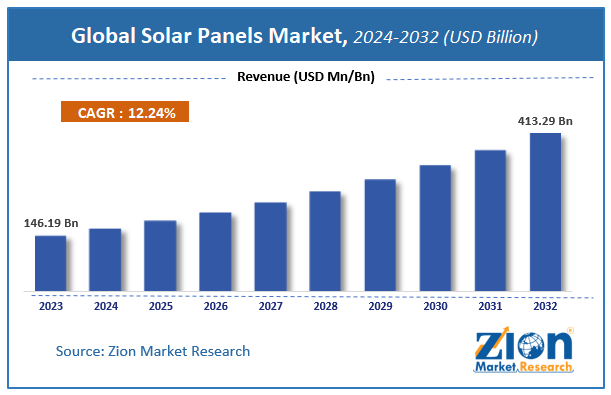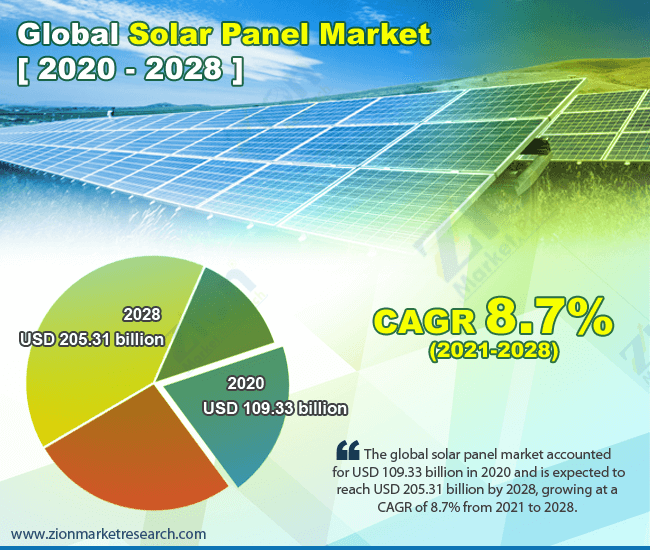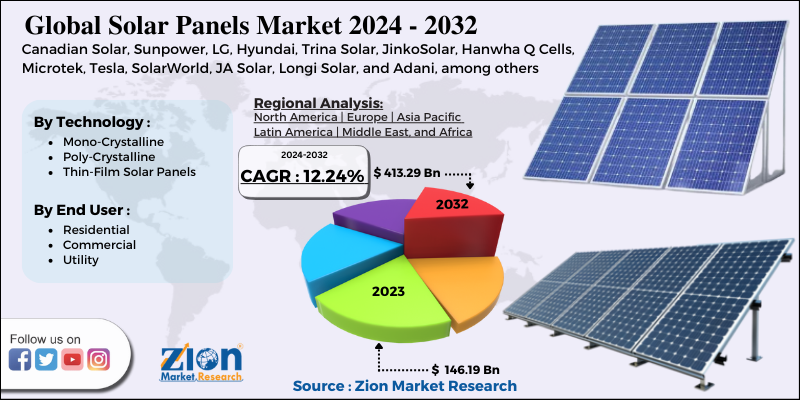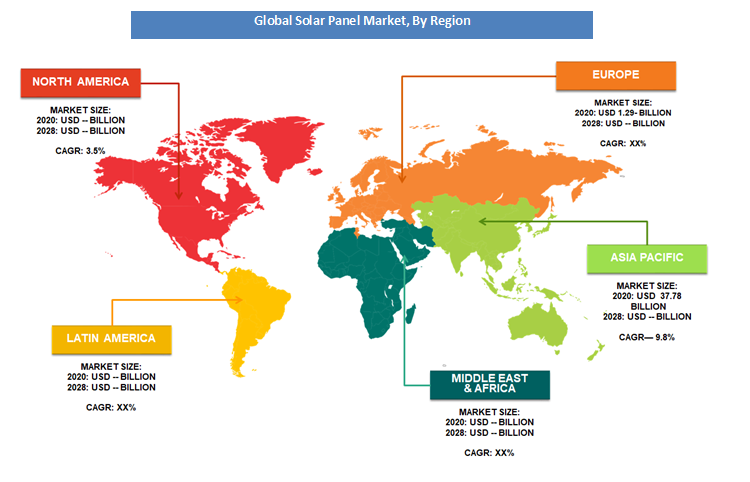Solar Panels Market Size, Share, Analysis, Trends, Growth 2032

Solar Panels Market By Technology (Mono-Crystalline, Poly-Crystalline, And Thin-Film Solar Panel), By End User (Residential, Commercial and Utility): Global Industry Perspective, Comprehensive Analysis and Forecast, 2024-2032
| Market Size in 2023 | Market Forecast in 2032 | CAGR (in %) | Base Year |
|---|---|---|---|
| USD 146.19 Billion | USD 413.29 Billion | 12.24% | 2023 |
Solar Panels Market Insights
Zion Market Research has published a report on the global Solar Panels Market, estimating its value at USD 146.19 Billion in 2023, with projections indicating that it will reach USD 413.29 Billion by 2032. The market is expected to expand at a compound annual growth rate (CAGR) of 12.24% over the forecast period 2024-2032. The report explores the factors fueling market growth, the hitches that could hamper this expansion, and the opportunities that may arise in the Solar Panels Market industry. Additionally, it offers a detailed analysis of how these elements will affect market demand dynamics and market performance throughout the forecast period.
Solar Panels Market: Overview
Solar energy is a clean source of energy and is present in abundant quantity available to our planet. Solar energy is radiated energy by the sun. It is an unconventional and convenient source of energy. Solar energy is also a solution to global warming and greenhouse gases effect. Solar energy is an alternative to fissile fuel which harms our environment Developed and developing economies around the globe are promoting solar energy as a main alternative source of energy. Governments are launching various schemes to promote the use of solar Panels.
Governments have set clean energy targets to which they are committed. Paris agreement is one such example and its member nations are committed to fulfilling its target and helping decarbonize the economy. In order to harness this energy different technology are used such as Mono-Crystalline, Poly-Crystalline, and Thin-Film Solar Panels.
This lockdown crippled the manufacturing industry as they were short of labor forces. The restrictions imposed by various nations to contain COVID had stopped production resulting in disruption across the whole supply chain. Thaw the manufacturing was hampered during the early lockdown phase but was later allowed due to its growing demand and ease in lockdown restriction. However, the world markets are slowly opening to their full potential, and theirs a surge in demand for Solar Panels Market. The market would remain bullish in the upcoming year.
Solar Panels Market: Growth Factors
Various agreements signed by governments in order to save the environment has made global energy producer shift their focus to clean energy sources across the globe. The government is providing Incentives and tax rebates are given to install solar Panels to decrease environmental pollution. Rooftop solar installation is one of the most common uses of solar Panels. The decrees in solar Panels prices due to various innovations and research have moved the focus to solar usage.
Europe and china are leading the way in solar technology and have stabilized the solar Panels prices to a lower rate than earlier. Investors are seeing this as an opportunity to set up solar projects at commercial levels. Governments are promoting rural use of solar power plants. In total, about 630 KW of clean energy was produced using solar installations around the globe, of which more than 50 % was harnessed in the Asia Pacific region. Europe is one of the largest energy producers using solar Panels.
Solar Panels Market: Segment Analysis
Mono-Crystalline solar Panels are made using silicon. Silicon bars are made using the single crystal growth method and put on wafers and placed in the right direction. Mono refers to a single-bar silicon structure. It’s a premium solar product as it has higher efficiency compared to Polycrystalline solar Panels. Some of the major companies producing Mono-Crystalline solar Panels are Canadian Solar, Sunpower, LG, Hyundai, Trina Solar, etc.
Polycrystalline solar Panels are made using silica but instead of using single silica crystal manufacturers melt silica fragments and form a wafer on the Panels. It is cost-efficient compared to Mono-Crystalline solar Panels but is less efficient. They are used more commonly for residential purposes. It is found on rooftop solar Panels.
This is attributed to a large number of projects in the pipeline across the globe. Government and private company projects are lined up which will be all for utility purposes. The commercial sector is also set to boom as many private companies are setting up a solar power plant to harness solar energy to reduce their liability in long run. The residential segment is steady rise as off-grid solar Panels with energy storage system proves to be alternative source of energy. Large batteries are required to save more power.
Solar Panels Market: Report Scope
| Report Attributes | Report Details |
|---|---|
| Report Name | Solar Panels Market |
| Market Size in 2023 | USD 146.19 Billion |
| Market Forecast in 2032 | USD 413.29 Billion |
| Growth Rate | CAGR of 12.24% |
| Number of Pages | 125 |
| Key Companies Covered | Canadian Solar, Sunpower, LG, Hyundai, Trina Solar, JinkoSolar, Hanwha Q Cells, Microtek, Tesla, SolarWorld, JA Solar, Longi Solar, and Adani, among others. |
| Segments Covered | By Technology, By End User Industry and By Region |
| Regions Covered | North America, Europe, Asia Pacific (APAC), Latin America, Middle East, and Africa (MEA) |
| Base Year | 2023 |
| Historical Year | 2018 to 2022 |
| Forecast Year | 2024 - 2032 |
| Customization Scope | Avail customized purchase options to meet your exact research needs. Request For Customization |
Solar Panels Market: Regional Analysis Preview
This is attributable to the presence of top companies such as Trina Solar, JinkoSolar, Hanwha Q Cells, Microtek, Tesla, SolarWorld JA Solar, Longi Solar, etc among others. Moreover, the increasing usage of the solar Panels market is expected to generate huge demand for the market in this region. China is the largest solar energy producer in the region. China also has the world’s largest floating solar field which generates about 40 MW of electricity. The Indian government is ambitious to achieve its 175 GW of renewable energy as a commitment to Paris Agreement by 2022.
The European region is projected to grow at a considerable CAGR over the forecast period. This surge is due to the increasing awareness of using clean sources of energy. Germany is the largest producer of electricity using solar Panels in this region followed by Spain. Cost reduction, user-friendly, efficiency, wide applications, convenience, etc. are some of the reasons why the solar Panels market is booming market in this region. The North American region had seen a surge in solar Panels usage as their residents were aware of the new utility project across the country in the coming years.
Solar Panels Market: Key Players & Competitive Landscape
Some of the key players in the solar Panels market are
- Canadian Solar
- Sunpower
- LG
- Hyundai
- Trina Solar
- JinkoSolar
- Hanwha Q Cells
- Microtek
- Tesla
- SolarWorld
- JA Solar
- Longi Solar
- Adani
The global solar Panels market is segmented as follows:
By Technology
- Mono-Crystalline
- Poly-Crystalline
- Thin-Film Solar Panels
By End User Industry
- Residential
- Commercial
- Utility
By Region
- North America
- The U.S.
- Canada
- Europe
- France
- The UK
- Spain
- Germany
- Italy
- Rest of Europe
- Asia Pacific
- China
- Japan
- India
- South Korea
- Southeast Asia
- Rest of Asia Pacific
- Latin America
- Brazil
- Mexico
- Rest of Latin America
- Middle East & Africa
- GCC
- South Africa
- Rest of The Middle East & Africa
Table Of Content
Methodology
FrequentlyAsked Questions
Zion Market Research has published a report on the global Solar Panels Market, estimating its value at USD 146.19 Billion in 2023, with projections indicating that it will reach USD 413.29 Billion by 2032.
The market is expected to expand at a compound annual growth rate (CAGR) of 12.24% over the forecast period 2024-2032.
Some of the key factors driving the global solar panel market growth are It is unconventional and convenient source of energy. Solar energy is also a solution towards global warming and greenhouse gases effect.
The Asia Pacfic region held a largest share in 2020. This is attributable to the presence of top companies such as Trina Solar, JinkoSolar, Hanwha Q Cells, Microtek, Tesla, SolarWorld JA Solar, Longi Solar,etc among others. Moreover, the increasing usage of solar panel market is expected to generate huge demand for the market in this region.
Some of the major companies operating in the solar panel market Canadian Solar, Sunpower, LG, Hyundai, Trina Solar, JinkoSolar, Hanwha Q Cells, Microtek, Tesla, SolarWorld JA Solar, Longi Solar, adani etc. among others.
RelatedNews
HappyClients
Zion Market Research
Tel: +1 (302) 444-0166
USA/Canada Toll Free No.+1 (855) 465-4651
3rd Floor,
Mrunal Paradise, Opp Maharaja Hotel,
Pimple Gurav, Pune 411061,
Maharashtra, India
Phone No +91 7768 006 007, +91 7768 006 008
US OFFICE NO +1 (302) 444-0166
US/CAN TOLL FREE +1 (855) 465-4651
Email: sales@zionmarketresearch.com
We have secured system to process your transaction.
Our support available to help you 24 hours a day, five days a week.
Monday - Friday: 9AM - 6PM
Saturday - Sunday: Closed








